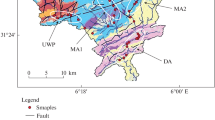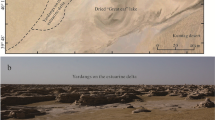Abstract
The red clay is a significant deposit underlying the Pleistocene loess-paleosols sequence in the Pannonian Basin. The sedimentary processes involved and the origin of the materials remain controversial. In order to determine the depositional processes of the Pliocene red clay formation we studied many red clay sections in Hungary. Here, we present results of grain-size analyses of the red clay from representative sites. In particular their grain-size distribution is compared with that of typical Pleistocene eolian loess-paleosols, as well as lacustrine and fluvial sediments. It appears from the sedimentological data that the majority of the red clay is of a wind-blown origin. The red clay might be transported by weak westerly winds and has been modified by post-depositional alteration.






Similar content being viewed by others
References
Ballenegger R (1917) About the clay soils of the foothills of the Tokaj Mountains (in Hungarian). Földt Közl (Bull Hung Geol Soc) 48:20–24
Bárdossy G, Aleva GJJ (1990) Lateritic bauxites. Developments in economic geology, vol 27. Elsevier, Amsterdam, pp 1–624
Berényi-Üveges J, Horváth Z, Michéli E, Mindszenty A, Németh T (2003) Reconstructing quaternary pedogenesis in a paleosol sequence in Hungary. Quat Int 106/107:61–71
Ding Z, Sun J, Yang S, Liu T (1998) Preliminary magnetostratigraphy of a thick eolian red clay-loess sequence at Lingtai, the Chinese Loess Plateau. Geophys Res Lett 25:1225–1228
Fábián SzÁ, Kovács J, Nagyváradi L, Varga G (2004a) Was there desert climate in the Carpathian Basin, or not? Studia Geomorphologica Carpatho Balcanica 38:49–58
Fábián SzÁ, Kovács J, Nagyváradi L, Varga G (2004b) Lower and Middle Pliocene palaeoclimate sedimentological evidences in the Pannonian Basin. Semin Proc 35:258–267
Fekete J (2002) Physical and chemical features of red clays in Northern Hungary. Acta Geol Hung 45:231–246
Fekete J, Stefanovits P, Bidló G (1997) Comparative study of the mineral composition of red clays in Hungary. Acta Agron Hung 45:427–441
Földvári M, Kovács-Pálffy P (2002) Mineralogical study of the Tengelic Formation and the loess complex of the Tolna Hegyhát and Morágy Hills areas (Hungary). Acta Geol Hung 45:247–263
Folk RL (1966) A review of grain-size parameters. Sedimentology 6:73–93
Koloszár L, Marsi I (2005) Formations of Late Neogene and Pleistocene terrestrial sediments in the region of Mórágy Hill (Hungary). Acta Geol Hung 48:317–337
Konert M, Vandenberghe J (1997) Comparison of laser grain-size analysis with pipette and sieve analysis: a solution for the underestimation of the clay fraction. Sedimentology 44:523–535
Kovács J (2003) Terrestrial red clays in the Carpathian Basin: a paleoenvironmental approach. Geomorphologia Slovaca 3:86–89
Kovács J (2006) Wind-blown origin of the Neogene red clay in the Pannonian Basin (abstract). Geophys Res Abstr 8:04182
Kretzoi M (1987) Remarks on the correlation between European and Asian Late Cenozoic local biostratigraphies. Vertebr Palasiat 25:145–157
Lóczy L (1886) Report of the detailed geological survey in 1886 (in Hungarian). Annual Report of the Geological Institute of Hungary, pp 1–115
Lu H, Vandenberghe J, An Z (2001) Aeolian origin and palaeoclimatic implications of the ‘red clay’ (north China) as evidenced by grain-size distribution. J Quat Sci 16:89–97
Magyar I, Geary GH, Müller P (1999) Paleogeographic evolution of the Late Miocene Lake Pannon in Central Europe. Palaeogeogr Palaeoclimatol Palaeoecol 147:151–167
Németh T, Berényi-Üveges J, Michéli E, Tóth M (1999) Clay minerals in paleosols at Visonta, Hungary. Acta Miner Petrogr Szeged 40:11–20
Passega R, Byramjee R (1969) Grain-size image of clastic deposits. Sedimentology 13:233–252
Pécsi M (1985) The Neogene red clays of the Carpathian Basin. Stud Geogr Hung 19:46–60
Pye K (1995) The nature, origin and accumulation of loess. Quat Sci Rev 14:653–667
Rónai A (1985) The quaternary of the Great Hungarian Plain. In: Pécsi M (ed) Loess and the quaternary. Akadémiai Kiadó, Budapest, pp 51–63
Sahu BK (1964) Depositional mechanism from the size analysis of clastic sediments. J Sed Petrol 34:73–83
Schweitzer F (1997) On late Miocene–early Pliocene desert climate in the Carpathian Basin. Z Geomorphol Suppl 110:37–43
Schweitzer F, Szöőr Gy (1997) Geomorphological and stratigraphical significance of Pliocene red clay in Hungary. Z Geomorphol Suppl 110:95–105
Smith BJ, Wright JS, Whalley WB (1991) Simulated aeolian abrasion of Pannonian sands and its implications for the origins of Hungarian loess. Earth Surf Proc Land 16:745–752
Sun D, Bloemendal J, Rea DK, Vandenberghe J, Jiang F, An Z, Su R (2002) Grain-size distribution function of polymodal sediments in hydraulic and aeolian environments, and numerical partitioning of the sedimentary components. Sediment Geol 152:263–277
Sun D, Bloemendal J, Rea DK, An Z, Vandenberghe J, Lu H, Su R, Liu T (2004) Bimodal grain-size distribution of Chinese loess, and its palaeoclimatic implications. Catena 55:325–340
Sümeghy J (1944) The territory east of the Tisza River (in Hungarian). Bull Geol Inst Hung Budapest, pp 1–208
Szabó J, Molnár J (1866) Description and classification of the soils of the foothills of the Tokaj Mountains (in Hungarian). Bull Math Nat Sci 4:1865–1876
Treitz P (1904) Agrogeological relations of the Mecsek Mountains and the Southern Zengő Mountain group (in Hungarian). Annual Report of the Geological Institute from 1904, pp 174–195
Vadász E (1956) Bauxite and “terra rossa” (in Hungarian). Földt Közl (Bull Hung Geol Soc) 84:115–119
Vendl A (1957) Geology I (in Hungarian). Tankönyvkiadó, Budapest, pp 1–623
Viczián I (2002a) Clay mineralogy of quaternary sediments covering mountainous and hilly areas of Hungary. Acta Geol Hung 45:265–286
Viczián I (2002b) Typical clay mineral associations from geological formations in Hungary: a review of recent investigations. Geol Carpathica 53:65–69
Visher GS (1969) Grain size distributions and depositional processes. J Sed Petrol 39:1074–1106
Wright JS (2001) “Desert” loess versus “glacial” loess: quartz silt formation, source areas and sediment pathways in the formation of loess deposits. Geomorphology 36:231–256
Yang SL, Ding ZL (2004) Comparison of particle size characteristics of the Tertiary ‘red clay’ and Pleistocene loess in the Chinese Loess Plateau: implications for origin and sources of the ‘red clay’. Sedimentology 51:77–93
Acknowledgement
The author would like to thank Professor F. Schweitzer, G. Szöőr and Thomas Voigt for their most helpful comments and reviews. I also thank my colleagues S.Á. Fábián and G. Varga for the discussions and contribution during the field work. I am grateful to J. Dezső (Sediment Lab) for helping in grain-size analyses.
Author information
Authors and Affiliations
Corresponding author
Rights and permissions
About this article
Cite this article
Kovács, J. Grain-size analysis of the Neogene red clay formation in the Pannonian Basin. Int J Earth Sci (Geol Rundsch) 97, 171–178 (2008). https://doi.org/10.1007/s00531-006-0150-2
Received:
Accepted:
Published:
Issue Date:
DOI: https://doi.org/10.1007/s00531-006-0150-2




